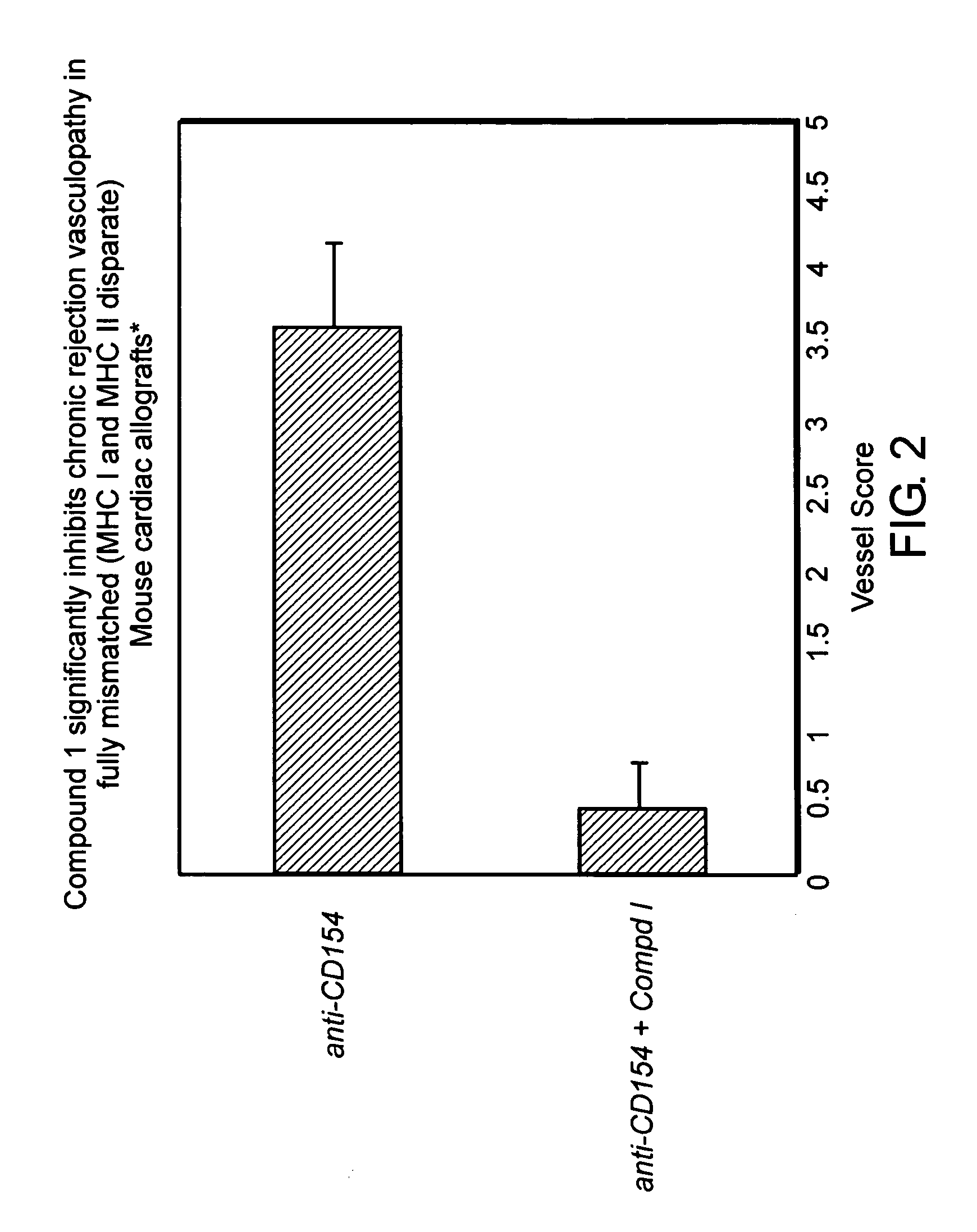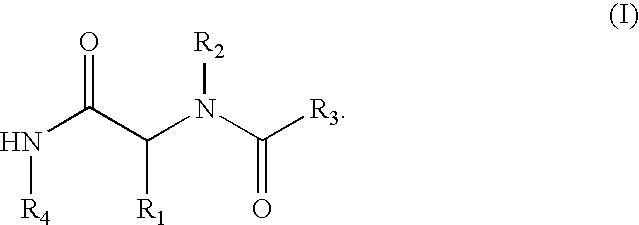Inhibition of chronic tissue transplant rejection
a technology of chronic tissue and transplant rejection, applied in the direction of biocide, immunological disorders, drug compositions, etc., can solve the problem of ineffective prevention of chronic tissue transplant rejection
- Summary
- Abstract
- Description
- Claims
- Application Information
AI Technical Summary
Benefits of technology
Problems solved by technology
Method used
Image
Examples
example 1
Suppression of Chronic Transplant Rejection Using Compound 1 in a First Mouse Model
[0079]The ability of Compound 1 to inhibit chronic transplant rejection in a mouse model was tested. Specifically, hearts from donor B6.C-H2bm12 mice were transplanted into C57 / BL6 recipient mice (MHC II mismatch) using standard protocol described in Hancock, W. W., et al. Proc. Natl. Acad. Sci. USA 93: 13967 (1996) and Yuan et al., Transplantation 73:1736, the entire teachings of which are incorporated herein by reference. Following surgery, the mice were divided into the following treatment groups with seven mice each:
[0080]Group I was a control group that was untreated.
[0081]Group II was treated with Compound 1 at a dose of 75 mg / kg / day subcutaneously for fourteen days following surgery.
[0082]At eight weeks following transplant surgery, the mice were sacrificed and evaluated for chronic rejection accelerated atherosclerosis. Briefly, transplanted hearts were fixed in formalin, embedded in paraffin ...
example 2
Suppression of Chronic Transplant Rejection Using Compound 1 in a Second Mouse Model
[0083]The ability of compound 1 to inhibit chronic transplant rejection was tested in a mouse heterotypic allogeneic heart transplant model in which acute allograft rejection was prevented with CD154 blockade as previously described (Hancock, W. W. et al. 1996. Proc. Natl. Acad. Sci. USA. 93:13967; and Yuan et al., Transplantation 73:1736). Briefly, this model consists of fully mismatched cardiac allografts (C57 / BL 6 donor with Balb / C recipient). Acute rejection occurred in all transplant recipients within 10 days post surgery without treatment, while treatment with Compound 1 alone resulted in a statistically significant extension in transplant survival to about 20 days. A third group in which acute rejection is blocked by administering a single 250 μg dose of anti-CD154 (anti-CD40 ligand) monoclonal antibody was established, and acute rejection (as evidenced by cessation of contraction of the trans...
example 3
Suppression of Transplant Rejection Using Compound 1
[0084]The ability of Compound 1 to inhibit transplant rejection in a mouse model was tested. Specifically, the heart from C57 / BL6 mice was transplanted into Balb / c recipient mice (total MHC mismatch) using standard protocol described in Hancock, W. W., et al. “Costimulatory function and expression of CD40 ligand, CD80 and CD86 in vascularized murine cardiac allograft rejection”Proc. Natl. Acad. Sci. USA 93: 13967 (1996). Following surgery, the mice were divided into the following treatment groups:[0085]Group I is a control group that was untreated.[0086]Group II was treated with Compound 1 at a dose of 75 mg / kg / day subcutaneously for fourteen days following surgery.
Control mice receiving no treatment reproducibly experienced rejection of their transplanted hearts after only ten days. Mice receiving Compound 1 alone showed a statistically significant delay (two to three weeks) (p
PUM
| Property | Measurement | Unit |
|---|---|---|
| weight percent | aaaaa | aaaaa |
| of time | aaaaa | aaaaa |
| microstructures | aaaaa | aaaaa |
Abstract
Description
Claims
Application Information
 Login to view more
Login to view more - R&D Engineer
- R&D Manager
- IP Professional
- Industry Leading Data Capabilities
- Powerful AI technology
- Patent DNA Extraction
Browse by: Latest US Patents, China's latest patents, Technical Efficacy Thesaurus, Application Domain, Technology Topic.
© 2024 PatSnap. All rights reserved.Legal|Privacy policy|Modern Slavery Act Transparency Statement|Sitemap



